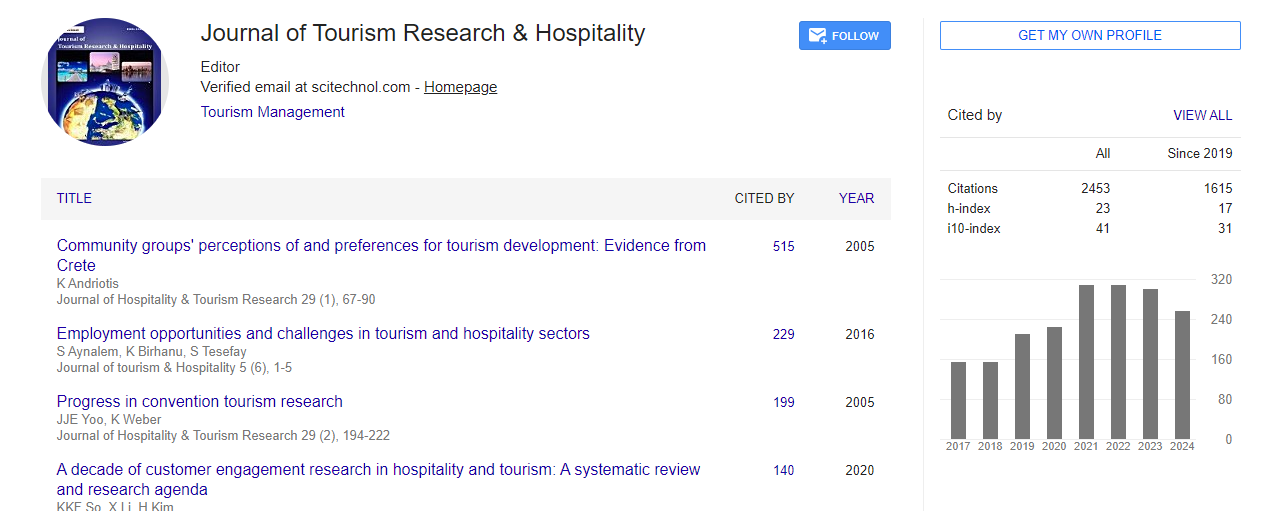Perspective, J Tourism Res Hospitality Vol: 13 Issue: 3
Health and Safety Standards: Essential Guidelines for the Hospitality Industry
Sevil Lemke*
1Department of Hospitality Management, University of Central Florida, Florida, USA
*Corresponding Author: Sevil Lemke,
Department of Hospitality, University of
Central Florida, Florida, USA
E-mail: sevil.l@gmail.com
Received date: 24 May, 2024, Manuscript No. JTRH-24-143393;
Editor assigned date: 27 May, 2024, PreQC No. JTRH-24-143393 (PQ);
Reviewed date: 14 June, 2024, QC No. JTRH-24-143393;
Revised date: 21 June, 2024, Manuscript No. JTRH-24-143393 (R);
Published date: 28 June, 2024, DOI: 10.4172/2324-9110.1000186.
Citation: Lemke S (2024) Health and Safety Standards: Essential Guidelines for the Hospitality Industry. J Tourism Res Hospitality 13:3.
Description
The hospitality industry, encompassing hotels, restaurants, resorts, and other accommodation and service sectors, is a dynamic field where health and safety regulations are important. These regulations are designed to protect guests, employees, and the overall operational integrity of establishments. As the industry evolves with increased global travel and changing consumer expectations, adhering to stringent health and safety standards becomes imperative. This study provides a comprehensive overview of health and safety regulations in the hospitality industry, exploring their significance, key areas of focus, and best practices for implementation.
Ensuring a safe environment for guests helps prevent accidents and illnesses, enhancing their overall experience and satisfaction. Safe working conditions contribute to staff well-being, reducing the risk of injuries and illnesses that could impact productivity and morale. Adhering to health and safety laws prevents legal liabilities and potential fines, protecting the establishment from costly legal issues. A commitment to high safety standards enhances the reputation of the establishment, attracting more guests and fostering loyalty.
Key areas of focus in health and safety Regulations
Fire safety is paramount in hospitality settings due to the high occupancy rates and diverse activities that occur. Key regulations include: Establishments must install and maintain fire detection and alarm systems to provide early warning in case of a fire. Properly maintained fire extinguishers, sprinklers, and other firefighting equipment must be readily available. Clearly marked and unobstructed emergency exits are essential, with appropriate signage to guide guests and staff to safety. Regular fire drills and training ensure that staff are prepared to respond effectively in the event of a fire.
Food safety and hygiene
Regular cleaning and sanitizing of kitchen equipment, utensils, and surfaces to prevent contamination. Proper storage of food items at correct temperatures to inhibit bacterial growth. This includes monitoring refrigeration and freezing units. Employees must adhere to strict personal hygiene practices, including handwashing and wearing appropriate protective clothing. Staff involved in food preparation and handling should receive training and certification in food safety standards, such as ServSafe. Regular cleaning and disinfection of guest rooms, public areas, and employee workspaces. Implementing pest control measures to prevent infestations that can compromise health and safety. Proper handling and laundering of bed linens, towels, and uniforms to ensure cleanliness and prevent crosscontamination. Provision of appropriate PPE for staff, especially in roles that involve handling hazardous materials or performing highrisk tasks.
Designing workspaces and tasks to minimize strain and injuries, such as providing adjustable chairs and proper lifting techniques. Implementing safety measures to prevent accidents, such as slipresistant flooring and proper signage for hazards. Providing training on safe work practices, emergency procedures, and the use of safety equipment. Offering support for mental health, including stress management resources and counselling services. Implementing security protocols, including surveillance systems, secure access controls, and staff training on handling security incidents. Developing and regularly updating emergency response plans for various scenarios, including natural disasters, medical emergencies, and security threats. Ensuring that staff are trained in first aid and CPR to provide immediate assistance in case of medical emergencies. Developing comprehensive health and safety policies tailored to the specific needs of the establishment is the first step. These policies should address all relevant areas, including fire safety, food safety, hygiene, and emergency preparedness.
Policies should be documented, regularly reviewed, and updated as necessary. Training is essential for ensuring that all staff members are aware of and adhere to health and safety regulations. Training programs should be ongoing, covering initial orientation as well as regular refreshers to keep staff updated on new regulations and best practices. Conducting regular inspections and audits helps identify potential hazards and ensure compliance with health and safety standards. These inspections should cover all areas of the establishment, including guest rooms, kitchens, and employee workspaces. Findings should be documented, and corrective actions should be implemented promptly. Establishing a system for reporting and analyzing incidents, such as accidents or safety breaches, is essential for continuous improvement. Reports should be reviewed to identify trends and areas for improvement, and corrective measures should be taken to prevent recurrence. Health and safety regulations and practices should be continuously reviewed and improved.
Conclusion
Health and safety regulations in the hospitality industry are perilous for ensuring the well-being of guests and employees, maintaining operational integrity, and complying with legal requirements. By focusing on key areas such as fire safety, food safety, hygiene, occupational health, and security, and implementing effective policies, training, inspections, and continuous improvement practices, establishments can generate a safe and enjoyable environment for all. Addressing challenges and adapting to evolving standards will further enhance the effectiveness of health and safety measures, contributing to the long-term success and reputation of hospitality businesses.
 Spanish
Spanish  Chinese
Chinese  Russian
Russian  German
German  French
French  Japanese
Japanese  Portuguese
Portuguese  Hindi
Hindi 

